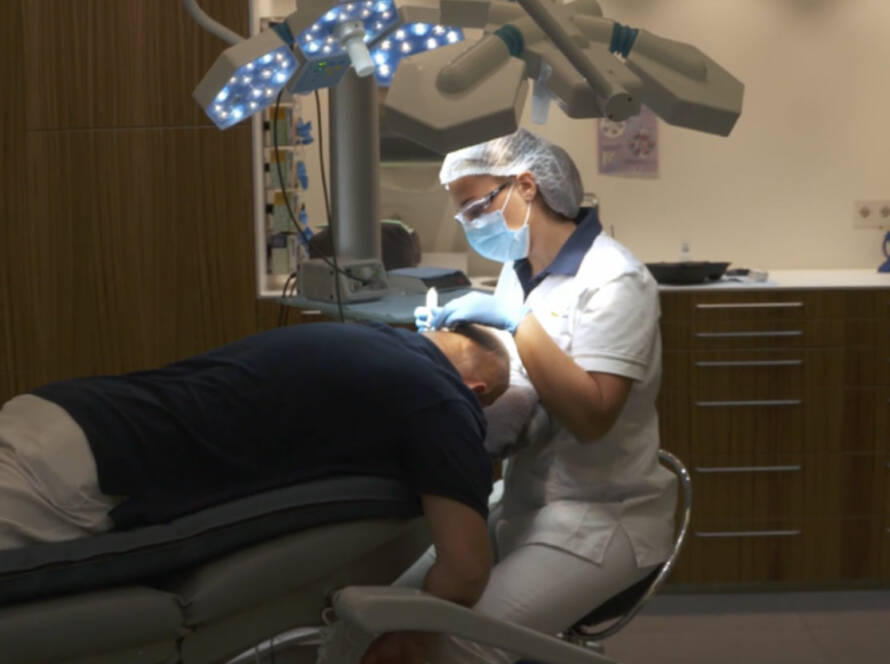Frontal fibrosing alopecia (FFA) is a form of hair loss that occurs mainly in post-menopausal women. It is a subtype of Lichen Planopilaris (LPP), a form of hair loss caused by inflammation resulting in scarring of the scalp.
The causes of this condition are not yet fully understood, but there are several factors that may play a role. One of the main causes seems to be hormonal changes. As women age and enter menopause, their hormone balance changes, which can lead to hair loss.
In addition, genetic factors may also play a role in the development of frontal fibrosing alopecia. The condition has been shown to be more common in people with a family history of hair loss. Autoimmune reactions are also associated with frontal fibrosing alopecia, in which the immune system attacks and damages the hair follicles.
More common
Finally, environmental factors such as sun exposure, smoking and stress may possibly contribute to the development of this hair disease. Because it is becoming more common, a link is being made to synthetic UV filters, which have been more frequently incorporated into sunscreen and day creams in recent years. Some recent studies link FFA to the use of synthetic UV filters such as Benzoyl Salicylate, Titanium Dioxide, Oxybenzone and Avabenzone.
Although the exact cause of frontal fibrosing alopecia is still unknown, a combination of genetic, hormonal and environmental factors seem to play a role.
Characteristics
Frontal fibrosing alopecia (FFA) usually presents as gradual hair loss on the front and sides of the scalp and may be accompanied by itching and a burning sensation. Over time, the skin around the hair follicle may contract, destroying the hair follicle and causing permanent hair loss.
Complete or partial loss of the eyebrows is classic and is sometimes the first symptom. Another feature of FFA is the presence of a shiny, raised ridge at the front of the hairline area, known as the ‘friction ridge’. In addition, there may be itching, burning or pain in the affected area.
Diagnosis
The diagnosis of FFA is made on the basis of clinical and histopathological (tissue examination) findings.
Treatment of FFA
There is currently no known cure for this condition. Treatment options such as corticosteroids, hormone therapy and immunosuppressive drugs can slow the progression of hair loss and help manage symptoms. It is important to recognise FFA early and seek treatment to prevent further progression of the condition and psychological impact.
Because it is a scarring form of alopecia, hair transplantation is the only treatment that can grow new hair on the scarred areas. However, the disease can flare up again, which can cause the transplanted hair to fall out again. Therefore, Hair Stem Cell Transplantation (HST), which preserves the donor area, is the only hair transplant method suitable for treating FFA.
Conclusion
FFA is considered a variant of lichen planopilaris, an inflammatory disease in which the (head) skin is affected. In a proportion of patients, it is combined with androgenetic alopecia (female pattern hair loss).
Frontal fibrosing alopecia can have a significant impact on the self-esteem and quality of life of affected individuals, as the hair loss is usually not reversible.
However, it is uncertain whether the treatment options used in lichen planopilaris also work in frontal fibrosing alopecia, and vice versa. It is agreed that the damage once done to hair follicles in frontal fibrosing alopecia is irreversible. Therefore, the main goal of therapy is to stabilise the alopecia.
If the condition is stable, or reasonably stable then hair transplantation can be considered. For this, the HST method is advised.
https://www.huidziekten.nl/zakboek/dermatosen/ltxt/lichen-planopilaris.htm
It is important to consult a dermatologist for proper diagnosis and treatment advice in frontal fibrosing alopecia.



